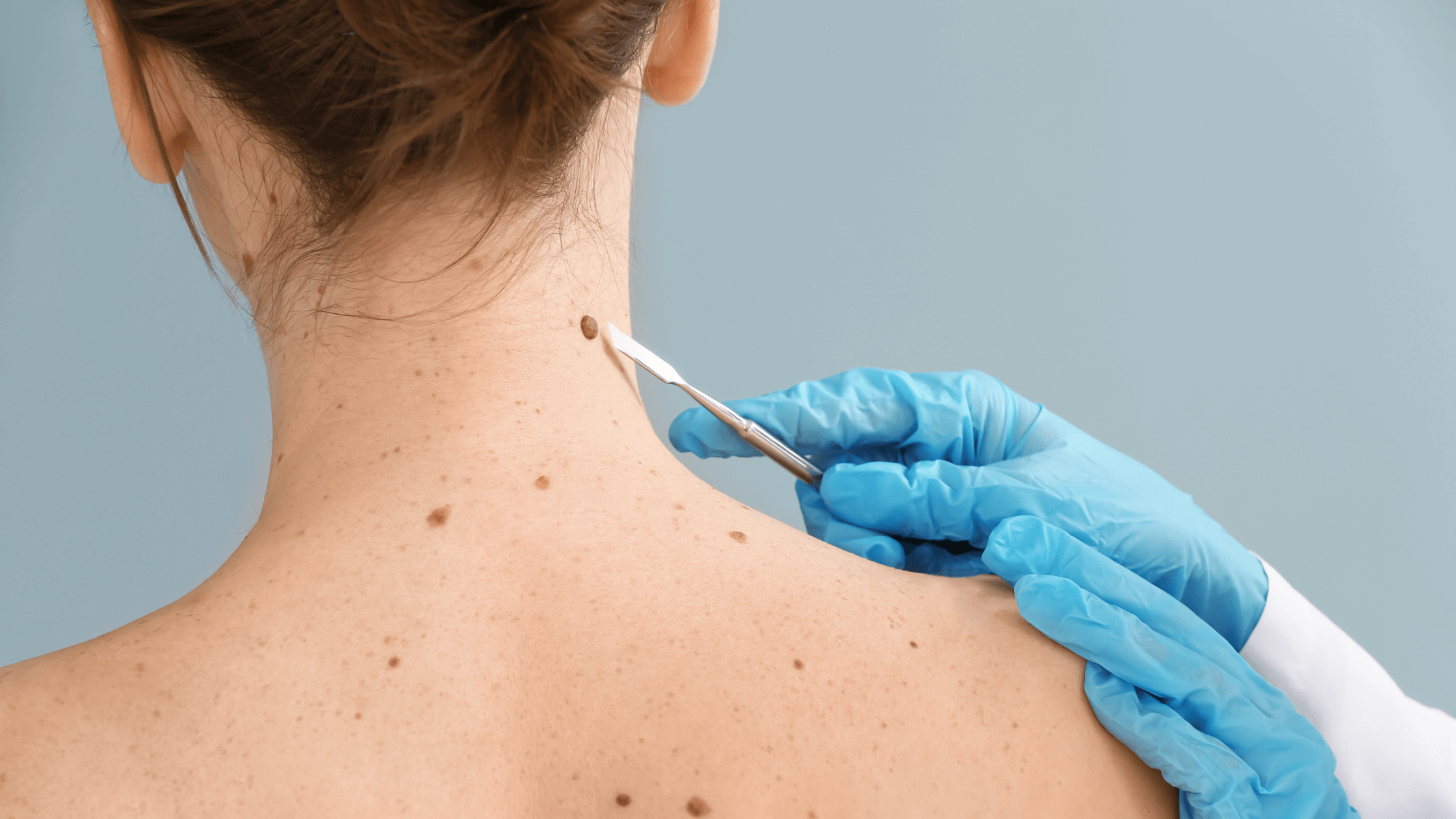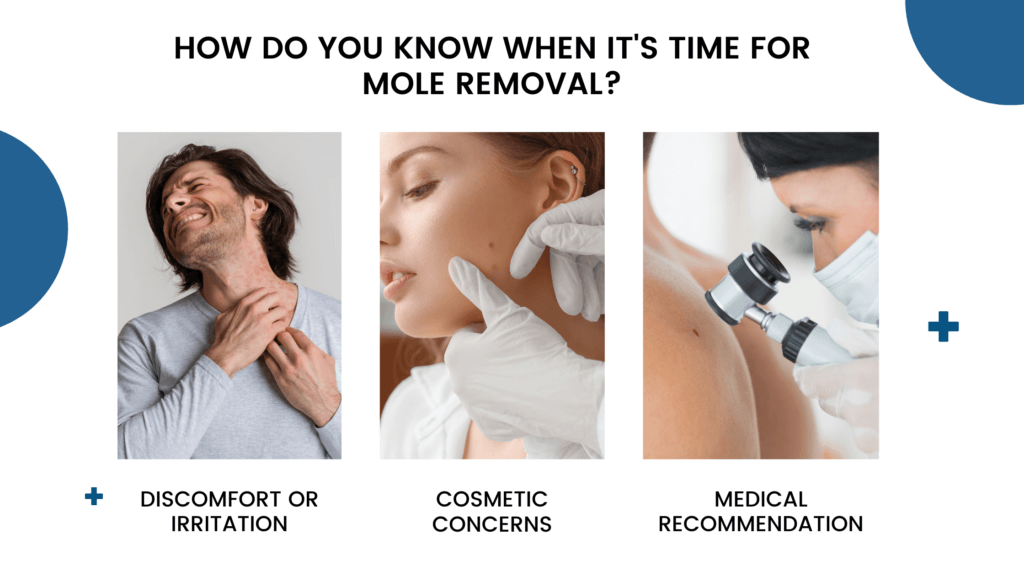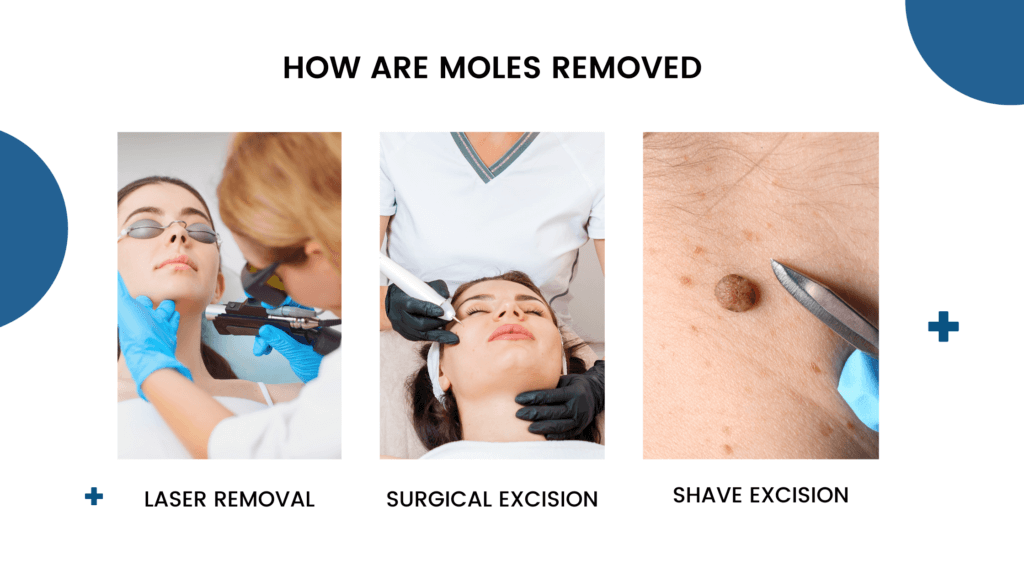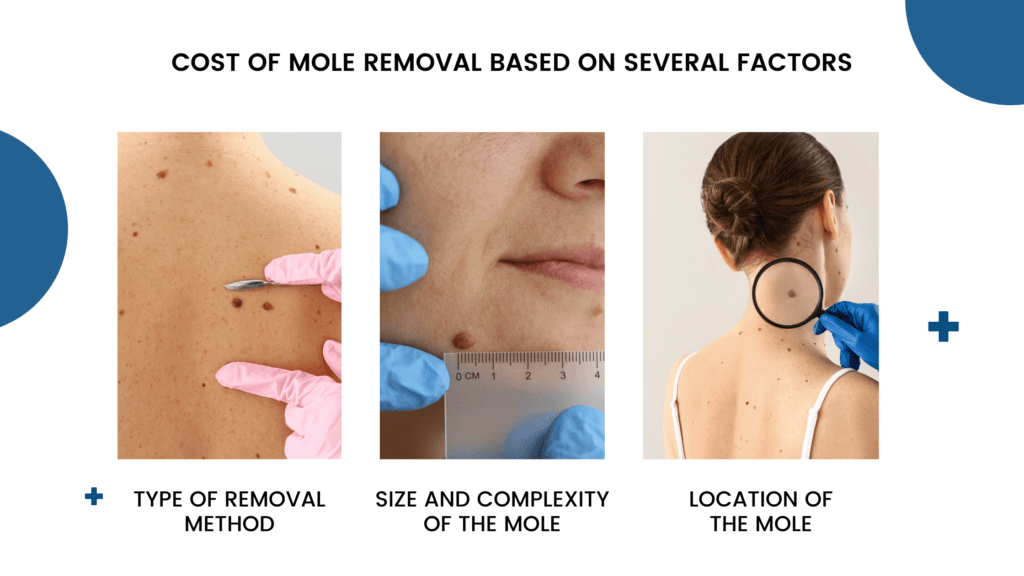Mole Removal: How Much Does It Cost?9 min read

Aesthetica Editorial Team

Whether it’s a tiny speck you’ve had since childhood or a new arrival that’s caught your eye, the decision to remove a mole is not just about aesthetics—it’s about your health and well-being too. But, as with any health-related decision, a crucial question arises: how much is it going to cost?
From surgical to laser options, we cover it all, empowering you with the knowledge to make a well-informed decision.
What Are Moles and Why Remove Them?
Moles, medically known as nevi, are common skin growths resulting from clusters of pigmented cells. They appear in various shapes, sizes, and colors, typically emerging during childhood and adolescence. Most people have between 10 to 40 moles by adulthood, with these numbers fluctuating over time and between person to person.
The reasons for removing moles can vary. For some, it’s a matter of aesthetics. A mole on a prominent place like the face or neck might be bothersome or impact self-esteem. For others, the concern is medical. Moles can evolve, and changes in their appearance can be a warning sign of skin cancer, particularly melanoma.
In some cases, moles are removed for comfort. Moles located in areas where they are constantly rubbed by clothing or jewelry can become irritated and painful. Regardless of the reason, mole removal is a standard procedure, often quick and with minimal discomfort.
How Do You Know When It's Time for Removal?

Determining when to remove a mole is a personal decision, here are some factors to consider:
Change in Appearance: Any noticeable change in a mole’s color, size, shape, or texture warrants a consultation with a doctor. These changes could indicate potential skin cancer or other skin conditions.
Discomfort or Irritation: Moles that repeatedly get caught on clothing, bleed, or become itchy should be examined. Removal might be recommended to prevent further discomfort.
Cosmetic Concerns: If a mole affects your self-image or you find it unsightly, especially if it’s on a visible part of your body, you might opt for removal for cosmetic reasons.
Medical Recommendation: Following a skin examination, your doctor may advise removing a mole if it looks suspicious or has a higher risk of turning into skin cancer.
The ABCDE rule is a simple guide to monitor moles for Asymmetry, Border irregularity, Color changes, Diameter greater than 6mm, and Evolving size, shape or color.
Remember, any decision for mole removal should ideally be made in consultation with a healthcare professional like Dr. Chang.
How Are Moles Removed?

Mole removal is a tailored process, significantly influenced by the mole’s characteristics such as its depth, size, and location.
Laser Removal: Ideal for superficial moles, i.e., seated on the skin’s surface. This method involves using highly focused light beams to break down the pigmentation in the mole. Laser removal is minimally invasive and favored for its precision and quick recovery time.
Surgical Excision: This technique is employed for deep-seated moles, where mere surface treatment isn’t adequate. During an excision, Dr. Chang will cut out the mole along with a margin of healthy skin around it. This is done under local anesthesia to ensure the your comfort. The depth and size of the mole dictate the extent of the excision. After the mole is removed, the incision is closed with sutures. This method is highly effective but may leave a small scar, depending on the mole’s size and the patient’s skin type.
Shave Excision: Used for moles that protrude above the skin. In this method, the mole is carefully ‘shaved’ off at skin level or slightly below it, using a surgical blade. While this technique can leave a slight residual pigment or may require a repeat procedure, it is less invasive than full excision and typically leaves minimal scarring.
It’s crucial to have a thorough consultation with Dr. Chang to understand the best course of action. He will evaluate the mole and discuss the most suitable removal method, considering not only the medical aspects but also the aesthetic outcomes.
What Is Mole Mapping and Why Does It Matter?
Mole mapping is a critical step in the journey of mole assessment and removal, serving as an effective tool for skin health surveillance. It involves creating a detailed record of the moles on a person’s body, essentially mapping their size, shape, and location.
By documenting the existing moles, Dr. Chang ensures that you can keep a vigilant eye on any changes that occur over time. This is crucial because alterations in a mole’s appearance—such as changes in size, shape, color, or texture—can be early indicators of skin cancer.
Mole mapping isn’t just about keeping track of the moles you already have. It’s also instrumental in identifying the emergence of new moles. The appearance of new moles, particularly in adulthood, warrants closer examination, as this could also be a sign of skin anomalies.
How Much Does Mole Removal Cost?

The cost of mole removal can vary significantly based on several factors, making it a question with no one-size-fits-all answer.
Type of Removal Method: Different methods, such as surgical excision, laser removal, or cryotherapy, come with varying costs. Surgical methods are generally more expensive due to their complexity. In contrast, less invasive methods like laser removal might be more affordable.
Size and Complexity of the Mole: Larger or more complex moles, which require more time and expertise to remove, tend to be more costly. This is especially true for moles that are deep-seated and require surgical excision.
Location: The part of your body where the mole is located can also affect the cost. Moles in sensitive or hard-to-reach areas may require more specialized techniques for removal, thereby increasing the price.
Given these variables, prices can range widely. For a precise estimate, it’s best to consult with a dermatologist or skin specialist who can assess the specific characteristics of your mole.
Will Insurance Cover Your Mole Removal?
When it comes to insurance coverage for mole removal, the key determinant is the reason behind the procedure. Generally, cosmetic mole removals, where the primary purpose is to enhance appearance, are not covered by health insurance. In these cases, the entire cost of the procedure is usually borne out-of-pocket.
However, if the mole removal is medically necessary — for instance, if the mole is suspicious and needs to be biopsied for cancer screening — your health insurance may cover part or all of the costs. It’s essential to understand your insurance policy’s specifics, as coverage can vary greatly between different providers and plans.
In situations where a mole is removed for medical reasons, it’s advisable to get a pre-authorization from your insurance company before the procedure. This ensures that you are clear about the extent of coverage and any out-of-pocket expenses you might incur.
What to Expect Before, During, and After Mole Removal
Undergoing mole removal can be a straightforward process, but knowing what to expect at each stage can help alleviate any anxiety and prepare you for a smooth experience.
Before Mole Removal
The journey starts with a consultation with Dr. Chang. He will examine the mole, discuss removal options, and determine the best approach based on the mole’s characteristics.
If not already done, mole mapping may be conducted. This helps in monitoring the mole for any pre-existing or future changes.
You’ll need to inform Dr. Chang about your medical history, any medications you’re taking, and if you have any allergies. This information is crucial for ensuring a safe procedure.
Depending on the removal method, Dr. Chang may provide specific instructions to follow before the procedure. This could include avoiding certain medications or preparing the skin area.
Forever Young BroadBand Light (BBL) therapy stands out as a cutting-edge solution in treating acne scars. This innovative technology uses high-intensity light therapy to rejuvenate the skin, addressing acne scars and various other skin concerns.
During Mole Removal
Excision procedures are performed under local anesthesia, numbing the area around the mole to minimize discomfort.
The method of removal (surgical excision, laser therapy, etc.) will dictate the exact process. Generally, it involves either cutting out the mole with a small margin of skin or breaking down the mole tissue with a laser.
The procedure typically takes a short time, often less than an hour, depending on the mole’s size and depth.
After Mole Removal
Immediately after the procedure, you’ll receive instructions on how to care for the wound. This may include cleaning the area, applying ointment, and using bandages.
Recovery varies depending on the removal method. Generally, it’s quick, with minimal downtime. You might experience mild discomfort, redness, or swelling, which usually subsides within a few days.
Some methods, like surgical excision, may leave a small scar. Dr. Chang will advise on scar care and treatments to minimize its appearance.
If stitches are used, a follow-up appointment will be necessary for their removal. Additional follow-up may be required to monitor healing and, in cases of biopsy, to discuss the results.
Continued skin monitoring is important, especially if the mole was removed for medical reasons. Regular self-examinations and dermatologist visits are advised.

Ready to Take the Next Step in Mole Removal?
Meet us at 19500 Sandridge Way, Suite 350, Leesburg, VA 20176, or call us at (703) 574-4342 for a complimentary consultation with Board-Certified Plastic Surgeon Dr. Phillip Chang before proceeding with your procedure. If everything matches up, our team will help you navigate the entire process from beginning to end. Also, remember to check out our blog and social media for more information on cosmetic surgery trends!
Let Us Help You!
Our office can provide you with helpful information, schedule a free consultation, and walk you through the many services and procedures we provide.
Contact Dr. Chang's Office:
More Articles For You

The Latest Techniques in Double Chin Removal in Leesburg, VA
In the charming town of Leesburg, VA, where looking good and feeling great are top

The Art of Refining the Side Profile of a Woman through Plastic Surgery
In the realm of cosmetic enhancements, the side profile of a woman holds a pivotal

Enhance Now, Pay Later: Plastic Surgery Payment Plans in Leesburg, VA
In the picturesque town of Leesburg, VA, pursuing beauty and self-improvement is a journey many

Areola Reduction for Men in Loudoun County
In the heart of Loudoun County, where the beauty of nature meets bustling urban life,
